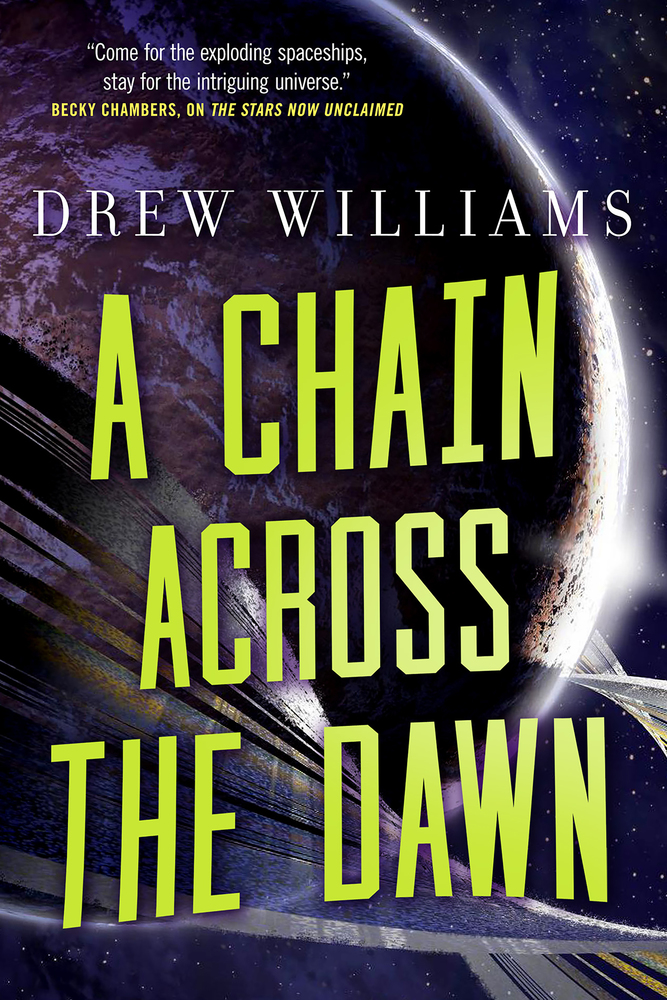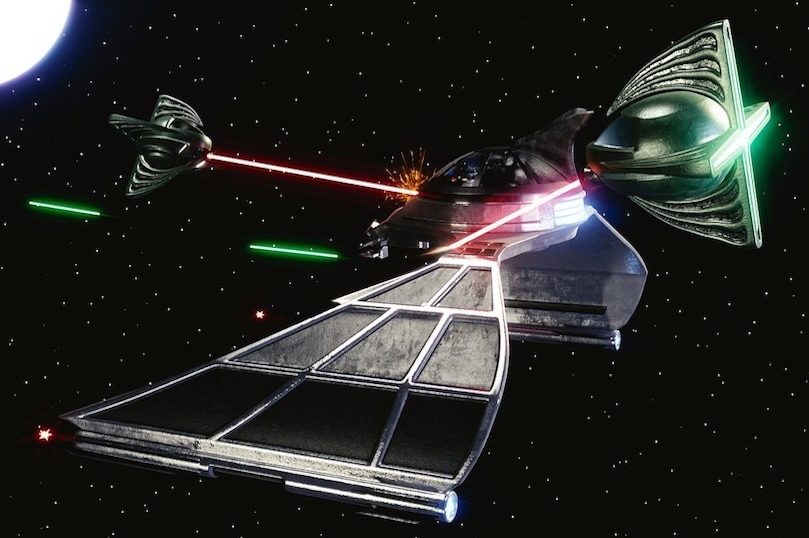As we prepare for the release of opens in a new windowA Chain Across the Dawn, the sequel to Drew William’s 2018 debut The Stars Now Unclaimed, we revisit Drew’s guest post about the most epic space battles of page and screen. A Chain Across the Dawn is on sale May 7!
—
opens in a new window Written by Drew Williams
Written by Drew Williams
Conflict is an inevitable part of humanity; we’ve been waging war since one clan of Neanderthals looked at another clan of Neanderthals and said, “Hey, their caves are nicer than ours and closer to prime hunting grounds. Let’s go jab at them with our spears (which we just invented yesterday), then take their caves for ourselves.” Utopian science fiction aside—which is a fine genre in its own right, but not at all germane to the subject at hand—it seems inevitable that war will follow us into the stars. And moral hand-wringing over the spiritual cost of violent conflict aside… space battles are frickin’ awesome. So, without further ado, the five coolest space battles of all time:
5) Starship Troopers (Robert Heinlein)
So, yes, even with the first entry, I’m bending the rules a bit, since the vast majority of Heinlein’s seminal novel doesn’t actually occur in space: most of it is urban combat against an aggressive alien enemy (and not the mindless “bugs” of Verhoeven’s 1997 film, which, though a brilliant satire and a fascinating look at how a director can completely invert the politics of his source material, is more a pastiche of what came before than anything particularly inventive in its own right, at least where the actual battles are concerned). Still, in terms of influence, it’s hard to get past Heinlein’s “grunt’s-eye-view” of future combat: his titular troopers would pave the way for every gung-ho space marine that followed, from the overconfident grunts of Cameron’s Aliens (mirroring the American engagement in Vietnam), to the icy-cool sociopath at the heart of Twohy’s Pitch Black (mirroring the injustices of America’s own penal system), to damn near every sci-fi video game protagonist from Halo’s Master Chief to Gears of War’s Marcus Fenix (mirroring the fact that… shooting big-ass science fiction guns at inhuman aliens is cool as all hell).
4) Cowboy Bebop – “Honky Tonk Women” (Shinichiro Watanabe)
You can say a great many things about Cowboy Bebop, but the first word that’s going to come to mind is always going to be “cool”. The jazz-infused neo-noir anime that follows the adventures of a disparate pack of loners somehow roped into serving together (though rarely enjoying it) on the titular starship is like science fiction Miles Davis: what should be a bunch of different, chaotic elements working against each other emerges as a wildly improvisational-seeming masterpiece, instead. Picking an episode for this column was difficult, as there are a wealth of great dogfights to choose from, but I ultimately went with “Honky Tonk Women” not just because of the ship-to-ship combat—both exhilarating and phenomenally pretty, as all the dogfights in Cowboy Bebop are—but of the zero-g stand-off at the climax, a clever usage of gravity and inertia that plays up the “space” part of the show’s “low-rent bounty hunters… in space” premise. Bebop excels at both the designs of its craft—witness the juxtaposition between main character Spike Spiegel’s dragonfly-like ship, aggressive and thrusting, versus Faye Valentine’s rounder, more versatile craft, one signifying a character who likes to end a fight as quickly as possible, the other his opposite number, who excels at adapting to whatever circumstances she finds herself in—and in the sheer sense of speed the anime lends its dogfights, both of which are on great display in “Honky Tonk Women”.
3) Battlestar Galactica (2004) – “33” (Ronald Moore)
You can make the argument that “Pegasus” (or perhaps the mid-season follow-up two-parter, “Resurrection Ship”) is actually the high-water mark for the Battlestar Galactica remake’s space combat, and you probably wouldn’t be wrong: “33” isn’t so much a “battle” as it is a “rout”. But that’s what makes it work so damned well: not all fights are won, at least not by the “good guys”. Technically the first episode of the series following the miniseries debut, “33” finds the last remnants of humanity in a desperate flight from the AI zealots intent (or so it seems) on their utter destruction. Episode director Michael Rymer uses a veritas handheld filmmaking style to really sell how exhausting the constant pursuit is for the characters on board the various ships in the fleet, how the greatest ally humanity’s AI opponents have is not their mechanized strength or lightning-quick intelligence, but the frailty of the human condition. When your opponent doesn’t tire, doesn’t rest, doesn’t quit, the physical limits of what the human body can take come into play, and humanity’s constant flight from the overwhelming force of their foes—who arrive 33 minutes after the fleet jumps into a new system, after every… single… jump to hyperspace—becomes a white-knuckle descent into tension and anxiety for the viewer, almost as much as it is for the characters.
2) Challenger’s Hope – “The Fish Attack” (David Feintuch)
There are two common directions to take with space battles, in terms of “metaphor your audience can easily grasp”: WWII Pacific Theater dogfights (single pilot fighters or small crew bombers launched from the aggressive “safe” envelope of heavily armed carriers) or Age of Sail naval engagements. (The third most common metaphor, “the starship as submarine,” is best exemplified by The Wrath of Khan, the sixth entry in this five-entry list.)
David Feintuch’s Seafort series takes the Age of Sail option, structuring not just his battle sequences but his entire space-faring society around an interstellar stand-in for the Napoleonic Wars-era British Navy, complete with a strictly regimented class system, a military service defined by “honor” and “duty”, and a level of emotional repression that only a society based on the British Empire during the Regency could manage. In the stand-out sequence of Challenger’s Hope (the second volume in the seven book cycle that mirrors C. S. Forester’s Hornblower novels, in which we follow the protagonist up the ladder of command throughout the series), the crew of the Challenger – their ship already deeply damaged, almost certainly not able to see them safely home – come face to face with the completely alien threat that has hounded them throughout the novel: a species of organic, space-faring creatures that utterly confounds everything they know about the galaxy. The sheer level of tension Feintuch creates purely through dialogue is one of the most exhilarating things you’ll ever read. The Captain recites Psalm 23 in his mind (“the Lord is my Shepherd”) acting as a counterpoint to the terrified screams of his crew that echo back and forth across the bridge and over an open comm channel, making an intense juxtaposition between the surety of faith and the chaos of the battle raging around their seemingly doomed vessel.
1) The Last Jedi – “The Bombing Run” (Rian Johnson)
I mean, let’s be honest: the question was never “would a Star Wars sequence” make this list but, “which sequence – from which film – would be chosen?” I could have gone for the trench run in the original film, because that’s the sequence that set the bar not just in the Star Wars universe, but in every other Star Wars-influenced space opera universe to come, otherwise known as… all of them. I could have gone for the opening waterfall shot of Revenge of the Sith, because yeah, I’m a prequel defender, and there’s no better sequence out there in terms of selling the scale of a space battle. I could have proved my Star Wars bonafides by choosing the season 3 finale of Rebels, because… well, mostly because it’s fantastic.
But in terms of what Star Wars does, the bombing run on the dreadnought near the opening of The Last Jedi is roughly five minutes of absolute perfection. Populated almost entirely by characters we’ve never met and (as of yet) don’t know the significance of, Johnson crafts a stunningly structured short film full of tension, pathos, bravery, and loss. It lets him simultaneously pay homage to the sort of films that inspired Star Wars space battles in the first place (films like Tora! Tora! Tora! and The Wings of Eagles), and begin to develop the themes that will play out in ways large and small across the rest of the picture. As the annihilation of the bombing wing plays out around it, a single bomber makes its way to its target area and the destruction of the supercraft preparing to kill off the entire Resistance comes down to one woman, injured and likely dying, desperately kicking at a metal strut to will her ship to succeed in its mission, no matter the cost. Whatever medal it was that Luke and Han received at the end of A New Hope, she absolutely deserves its posthumous award, as there’s no greater sequence of valor, determination, or sacrifice in the entirety of the Star Wars canon, and that’s what makes a great battle sequence: not the design of the ships or the maneuvers of the fleets, but the characters involved in the action and what the fight means to them and to the galaxy around them if they fail.
Plus, the whole sequence is… just… stupidly pretty.
Order Your Copy of A Chain Across the Dawn
opens in a new window opens in a new window
opens in a new window opens in a new window
opens in a new window opens in a new window
opens in a new window opens in a new window
opens in a new window

